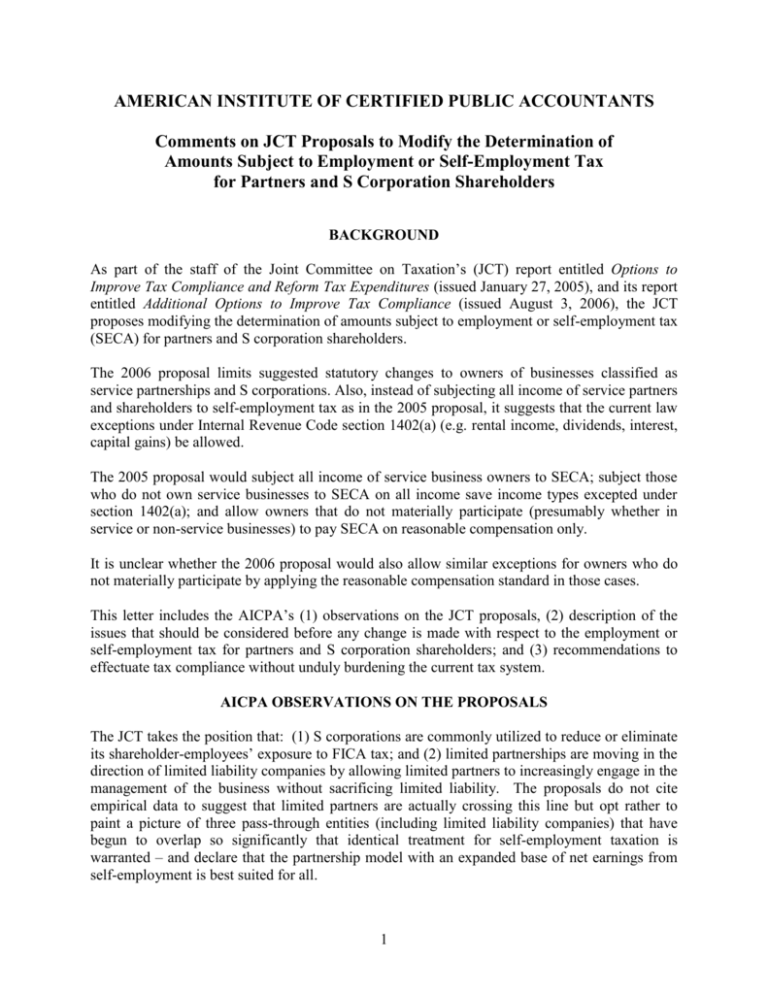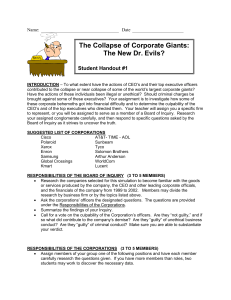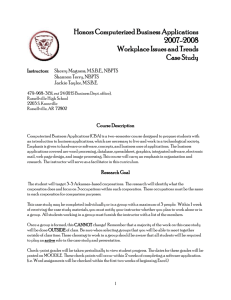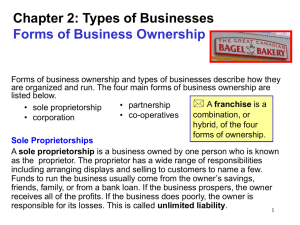Comments on the Joint Tax Committee's Self-Employment
advertisement

AMERICAN INSTITUTE OF CERTIFIED PUBLIC ACCOUNTANTS Comments on JCT Proposals to Modify the Determination of Amounts Subject to Employment or Self-Employment Tax for Partners and S Corporation Shareholders BACKGROUND As part of the staff of the Joint Committee on Taxation’s (JCT) report entitled Options to Improve Tax Compliance and Reform Tax Expenditures (issued January 27, 2005), and its report entitled Additional Options to Improve Tax Compliance (issued August 3, 2006), the JCT proposes modifying the determination of amounts subject to employment or self-employment tax (SECA) for partners and S corporation shareholders. The 2006 proposal limits suggested statutory changes to owners of businesses classified as service partnerships and S corporations. Also, instead of subjecting all income of service partners and shareholders to self-employment tax as in the 2005 proposal, it suggests that the current law exceptions under Internal Revenue Code section 1402(a) (e.g. rental income, dividends, interest, capital gains) be allowed. The 2005 proposal would subject all income of service business owners to SECA; subject those who do not own service businesses to SECA on all income save income types excepted under section 1402(a); and allow owners that do not materially participate (presumably whether in service or non-service businesses) to pay SECA on reasonable compensation only. It is unclear whether the 2006 proposal would also allow similar exceptions for owners who do not materially participate by applying the reasonable compensation standard in those cases. This letter includes the AICPA’s (1) observations on the JCT proposals, (2) description of the issues that should be considered before any change is made with respect to the employment or self-employment tax for partners and S corporation shareholders; and (3) recommendations to effectuate tax compliance without unduly burdening the current tax system. AICPA OBSERVATIONS ON THE PROPOSALS The JCT takes the position that: (1) S corporations are commonly utilized to reduce or eliminate its shareholder-employees’ exposure to FICA tax; and (2) limited partnerships are moving in the direction of limited liability companies by allowing limited partners to increasingly engage in the management of the business without sacrificing limited liability. The proposals do not cite empirical data to suggest that limited partners are actually crossing this line but opt rather to paint a picture of three pass-through entities (including limited liability companies) that have begun to overlap so significantly that identical treatment for self-employment taxation is warranted – and declare that the partnership model with an expanded base of net earnings from self-employment is best suited for all. 1 The proposals would render virtually all S corporation income subject to self-employment tax, with few exceptions, especially with respect to service S corporations in the 2005 proposal. While the proposals treat both partners and S corporation shareholders alike, the proposals would most significantly change and have the most dramatic tax base increase on S corporation shareholders, many of whom are owners of a small family-owned business. A. The Proposals’ Impact on Choice of Entity The JCT proposals reiterate the concept that a choice-of-entity decision should not be influenced by tax considerations. We agree that economic neutrality and neutrality to business form are goals that a tax system should try to attain. These and other (often conflicting) goals are critical to any exercise in fundamental tax reform. However, because the concern of the JCT in its selfemployment tax proposals is perceived tax noncompliance rather than fundamental reform, we, therefore, address this concern in our review of the proposals. Based on our broad experience, it is our professional opinion that, in practice, taxpayers and their advisors generally make choice of entity decisions based on legitimate tax and non-tax factors, including: Capital structure and capital contribution requirements Compensation plan design Personal liability exposure Asset protection planning Corporate governance provisions Liquidation rights Industry standards and common practices State regulatory guidance Size and type of business Franchise, income, estate and gift taxes State and federal tax law complexity It is impossible to isolate self-employment tax -- or any other tax, for that matter -- as a major factor when deciding whether to form an S corporation because if each one of the above issues is not addressed, then taxpayers and their advisors have not properly analyzed the best choice of entity. Congress should consider that the decision concerning choice of entity is complex and takes into account more than a brief discussion of the self-employment issues. The JCT proposals highlight one of the long standing tax differences between S corporations, partnerships and limited liability companies (LLCs) – how the self-employment tax applies to the owners of these entities. Although general partners are subject to self-employment tax and limited partners (however defined) are only partially subject to self-employment tax, LLC 2 members have operated in an area of conflicting guidance for a number of years. However, because an S corporation is a corporation, their shareholders are not subject to self-employment tax; instead, shareholder-employees pay employment taxes on their paid compensation like any other employee. Further, LLCs seem to be the entity of choice for newly created business entities. While the tax rules (primarily statutorily-based) that are applicable to the compensation of owners of these entities are different for each type of entity, the inconsistent rules are not prima facia evidence that taxpayers are “abusing” the system. According to the IRS Statistics of Income Bulletins and the IRS Data Books, 1,580,300 partnership returns were filed for tax year 1994 and 2,530,846 for tax year 2004 – a 60 percent increase. Similarly, the number of S corporation returns filed increased 62 percent from 2,161,000 to 3,503,932 over the same period. We believe that the effective repeal of the General Utilities Doctrine in 1986 is responsible for this substantial increase in both partnership and S corporation returns and that an additional increase in partnership returns is due to the acceptance of LLCs as attractive pass-through entities in large part due to the check-the-box entity classification rules. In our opinion, self-employment tax exposure is one of many factors taxpayers consider in addressing the choice of entity question. If S corporations were chosen predominately to save employment taxes, one would expect to see a much higher increase in the use of S corporations relative to partnerships. The parallel growth of partnerships and S corporations and the fact that new entities are more likely formed as LLCs rather than as S corporations support the view that multiple factors drive the choice of entity decision. B. Conversion from Tax Withholding Regime The JCT proposals would require S corporations to convert from a payroll withholding regime to an estimated tax regime. An estimated tax regime would lead to compliance issues because of likely disputes between taxpayers and the government concerning the appropriate amount to tax. Further, this regime would be inconsistent with systems imposed by many states. We strongly believe that – even if portions of these proposals are enacted – S corporations should be allowed to elect to continue payroll tax withholding. The enforced discipline of income tax withholding helps many individual taxpayers satisfy their personal income tax liability throughout the year and avoids the possibility of being faced with underestimation penalties or large tax bills in April. Having the corporation administer the withholding program also minimizes taxpayer disputes with the government about what and how much should be taxed and paid. In our experience, many self-employed taxpayers, particularly low-to-moderate income individuals, do not always manage their finances well and have a difficult time consistently making quarterly estimated tax payments. Further complicating any transition away from the FICA/unemployment system, the vast majority of states treats closely-held S corporation stockholder-employees as employees and require state income tax withholding and unemployment tax payments. 3 If the self-employment tax base is expanded by enacting one of these proposals, we recommend including an exception allowing all S corporation shareholder-employees to remain under the FICA withholding system with regard to reasonable compensation. This would leave only the calculation of a stockholder’s noncompensatory self-employment tax liability (to be reported on Schedule K-1), which would have to be modified to account for the amount of compensatory taxes withheld. Even with this mild complication, utilizing income tax and FICA withholding (and possibly a continuation of unemployment insurance enrollment) based on reasonable compensation is a far superior approach that will minimize (1) government-taxpayer disputes and (2) the likelihood of a stockholder being faced with large estimated tax payments, or a large income tax liability in April. ISSUES TO BE CONSIDERED PRIOR TO ENACTING SECA CHANGES The JCT proposals, in part, intend to improve tax neutrality with a goal of minimizing tax considerations in choice-of-entity decisions among pass-through entities. However, because S corporations, partnerships and LLCs are subject to very different tax laws by design, a number of issues should be considered, including the following: A. No Pay – No Benefit Though this factor is typically dismissed, individuals who do not contribute to the OASDI/HI system receive no Social Security, Survivor, Disability or Medicare benefits. We realize that individuals with adjusted gross incomes above $150,000 are often not as dependent on receiving these benefits – particularly Social Security – but according to the U.S. Census Bureau’s 2004 Selected Economic Characteristics, this describes only 5.5 percent of the U.S. taxpayers. B. Independent Factors that Influence Compensation Plans 1. Reinvested Profits Often S corporations are prohibited from distributing profits to stockholders due to numerous business and legal restrictions such as bank loan covenants, bonding requirements, working capital needs and stockholder agreement provisions. Because of these real life limitations on S corporations’ business conduct, subjecting undistributed earnings to an employment-based tax would not be appropriate. Further, while partnerships pay self-employment tax on undistributed profits and are often subject to similar distribution restrictions, we believe that – to the extent undistributed profits are not attributable to the labor of the partners – those profits should also not be subjected to selfemployment taxation. We believe that the JCT proposals are incorrectly directed because the S corporation model often reflects more accurately than the partnership model the division between labor and capital and, therefore, is a more appropriate model to follow. 4 As we have previously proposed with regard to partnerships,1 the AICPA believes that a selfemployment tax system that recognizes a return on capital for its owners based upon invested resources is practical and reflects current economic business arrangements. While S corporation shareholders that actively participate in the S corporations can properly bifurcate their investment in the S corporation from their employment interests, partners in operating partnerships generally are required to subject their entire distributive share to self-employment taxation, even if capital is a material factor in the operating business. In the partnership world, the ability to obtain limited partner status partially offsets this disparity; therefore, S corporations – which lack any similar designation – must be permitted to continue such bifurcation. Although we agree that moving toward uniformity would assist compliance, a blending of the payroll tax regimes would be fairer and more economically justifiable if partners and shareholders are permitted a tax-free return on invested capital and the self-employment model were patterned more after the existing S corporation model today. 2. Multiple Stockholder Environment Many S corporations are owned by multiple, unrelated stockholders. The AICPA’s experience in these circumstances indicates that compensation is determined based on the work actually performed for the business. For example, an S corporation owned equally by two or more unrelated stockholders will often design a compensation plan for its owners based on specific factors (e.g., hours worked or sales generated). This concept is similar to the independent investor analysis applied in the Exacto Springs2 case. In this arm’s length relationship, the desire for adequate compensation will outweigh the desire to save money on employment taxes. 3. Social Security/Self-Employment Tax Should Apply Only to Labor The self-employment tax is intended to apply to income generated by an individual’s labor. Partnerships have long been divided into categories for determining how the self-employment tax applies, for example: (1) general versus limited partnerships; (2) bifurcated or multiple partnership interests; and (3) managing LLC member versus non-managing member. Further, uniform state partnership laws have always interacted with the Internal Revenue Code to help define the parameters of self-employment tax applicability. The question for S corporations is whether a shareholder provides services to the corporation. To the extent a shareholder works and receives reasonable compensation for such services, he or she should pay employment taxes. The S corporation employment tax system, in fact, is more logical than that used for imposing labor-based taxes on partners and reflects the original intent of the FICA and SECA rules by more clearly drawing the division between labor and capital. In our experience, the vast majority of operating S corporations and partnerships are engaged in business activities in order to generate a profit, and a majority of this profit is generated by the 1 See Letter of David A. Lifson, Chair, AICPA Tax Executive Committee, to the Honorable William V. Roth, Chairman, Senate Committee on Finance, dated June 22, 2000. 2 Exacto Spring Corp. v. Commissioner, 196 F.3d 833 (7th Cir. 1999) 5 efforts of the non-owner employees. Therefore, in these common cases, the corporation and partnership are already contributing to the FICA system by paying their share of employer FICA, and the net profit represents a return of capital to the stockholders and partners. Simply subjecting substantially all of an S corporation and partnership’s profit to self-employment tax is not appropriate because not all its profits can be attributed to the labor of its owners. In Pediatric Surgical Associates,3 the IRS, itself, argued that profit attributable to services performed by non-shareholder employees could not be treated as compensation when distributed to shareholder employees. Contrary to the Service’s position, the JCT proposal would apply self-employment tax to S corporation shareholders on their shares of the corporation’s net income. 4. Professional Service S Corporations and Partnerships Professional service S corporations and partnerships should not be treated differently from other S corporations and partnerships for the purposes of employment taxes. The JCT proposal would subject all income of professional service S corporations – including interest, dividends and rent – to self-employment tax. These types of income are clearly not derived from labor and, therefore, no acceptable policy reason supports removing the current-law exemptions applicable to both S corporations and partnerships. Under current law, the “reasonable compensation” standard applies to professional service S corporation stockholders – whether or not they materially participate in the business, as defined in section 469 of the Internal Revenue Code and the related regulations. The proposed modifications would apply the “reasonable compensation” standard only for stockholders and partners who do not materially participate in the business. AICPA RECOMMENDATIONS The AICPA believes that it is premature to enact either of the JCT proposals without first identifying whether a SECA tax avoidance problem exists. If a problem is determined to exist, the IRS should first utilize its existing system of enforcement to remedy the issue. There is no reason to further complicate the tax law by needlessly layering more rules. If the existing rules do not work, those rules should be analyzed and improved. If more enforcement of the existing rules is determined to be needed to achieve the intended goal, the AICPA stands ready to support the IRS with its enhanced enforcement efforts. A. Reliance on Current Tax Law The JCT proposals refer to the government’s difficulty in applying well-developed statutory and judicial tax law to the various pass-through entities due to the “facts and circumstances” nature of determining reasonable compensation. Although a facts and circumstances analysis of each case does require enforcement resources, we do not believe it is appropriate to significantly change the law in a manner that will greatly burden the majority of law-abiding taxpayers. 3 Pediatric Surgical Assoc. v. Commissioner, T.C. Memo 2001-81. 6 This is an enforcement issue, not a problem with the technical rules. We support IRS resources being used to enforce the current rules. A way to make enforcement easier and cost effective is to amend Forms 1120S, 1065 and Schedule K-1 to specifically provide the amount of compensation paid to shareholders. Currently, Form 1120S requires an S corporation to state the total amount of compensation paid to officers and to non-officers rather than to shareholders. To not utilize rules that are directly on point and to add further complicated rules is inconsistent with congressional (and our) desire to simplify the tax system. B. Regulatory Guidance The AICPA supports a congressional directive for Treasury to complete the development of selfemployment tax regulations that apply to members of LLCs. Without such a directive, Treasury and the IRS may neglect to create or finalize any guidance in this area. We believe that much of the impetus for a more uniform self-employment tax system for pass-through entities would decline and a reduction of the tax gap would occur if Treasury were to create certainty for members of LLCs by issuing final guidance in this area. The lack of enforceable selfemployment tax guidance for LLC owners has caused confusion and inconsistent reporting by tax practitioners and taxpayers. C. Results of Current Studies In 2002, the Treasury Inspector General for Tax Administration (TIGTA) issued a report (#220230-125) on the issue of S corporation distributions versus compensation – based on a limited sample of only 84 returns. This report concluded that Treasury should expand its efforts to address this issue through examination and enforcement. In July 2005, the IRS initiated a comprehensive audit program of 5,000 S corporation returns for the tax years 2003 through 2005. Until the results of this study have been fully vetted, no legislative action should be taken. This audit and enforcement approach recommended by TIGTA directly addresses concerns of potential abuse far better than the JCT proposed legislation without burdening the majority of compliant taxpayers because: (1) the audits will provide statistical data to help determine the extent of abuse far better than the TIGTA sample of 84 S corporation returns; and (2) it will enable the IRS to direct enforcement resources towards non-compliant taxpayers that are examined and, through “ripple effect,” cause non-examined taxpayers to be more diligent in their reporting. The audit results could show that the tax gap attributable to a lack of SE compliance is smaller than the JCT economists have anticipated or that willful avoidance of SE tax by S corporation shareholders is not material. Either of the two results would more likely be remedied most effectively with a targeted examination and enforcement program as opposed to an overreaching legislative change. D. Hearings and Public Comment We think that this issue affects a wide range of the American business community. It is important that S corporations and their owners have an opportunity to share their experiences with the appropriate lawmaking body. A public comment period and hearings should be encouraged by the JCT, by interested congressional committees, and by the IRS before deciding 7 whether to implement these or similar proposals. In addition, if the ultimate decision is to issue regulatory guidance, ample time should be reserved for input from the millions of active S corporations that operate in America. Based on the recommendations described above, the AICPA believes that the National Research Program’s S corporation audit program should be allowed to run its course, and the results analyzed to determine more accurately the true nature of the problem, prior to any significant statutory changes. We also believe that a regulation project addressing self-employment taxes affecting LLC members is a better answer than the legislative proposal under consideration. If any legislative movement towards unifying employment and self-employment taxes is to progress, we strongly suggest it be in the direction of the S corporation model, rather than the partnership model. CONCLUSION The JCT proposals would substantively change tax law in a way that adversely affects compliant taxpayers in order to enforce the law on the minority of those that are not compliant. The proposed changes are being justified in large part in response to: (1) state changes in limited partnership laws; (2) the resource-intensive nature of challenging the reported compensation of S corporation shareholders; and (3) the misbelief that it is increasingly common to choose the S corporation form primarily to escape employment taxes. Further, the JCT proposals fail to appreciate major and numerous inherent differences between a partnership-based and a corporation-based pass-through regime. Although the proposals focus on the differing ways that these entities contribute to the OASDI and hospital insurance programs, they go beyond a (complex) unification of regimes. The proposals would (1) alter the types of income that are subject to both employment and self-employment taxes (likely at both the federal and state levels), the persons that are subject to the taxes, and the standards for determining who is subject to the taxes; and (2) complicate the reporting and collection model for S corporation shareholders, without simplifying the system for partners. Ensuring that everyone pays their fair share of taxes is an important goal; however, these proposals are not the best means to this end. It is not appropriate to change: (1) a fairer tax base that exempts at least some non-labor types of income to an expanded base that is not reflective of the intent of the FICA and SECA systems of only taxing labor; and (2) a simpler, more effective withholding model to the more difficult estimated payment system that is subject to a higher level of noncompliance. Prior to undertaking such major changes in this area, Congress and/or the IRS should solicit testimony from taxpayers in a broad cross-section of industries and entities to develop a factual basis for some of the underlying assumptions made in these proposals. During the short and intermediate term while the appropriate fact gathering is being undertaken, a targeted examination of SE tax issues on S corporations returns can be conducted under existing laws with little additional cost to the government. Additionally, a modification to the Form 1120S to include additional disclosure would assist in the proper allocation of government recourses. 8 The AICPA supports the goal of simplifying and possibly unifying the reporting system (by expanding the FICA reporting model) for employment and self-employment taxes. However, moving away from the FICA withholding system standards and subjecting significantly increased amounts of capital in both S corporations and partnerships to self-employment taxes will not serve our tax system well. 9




